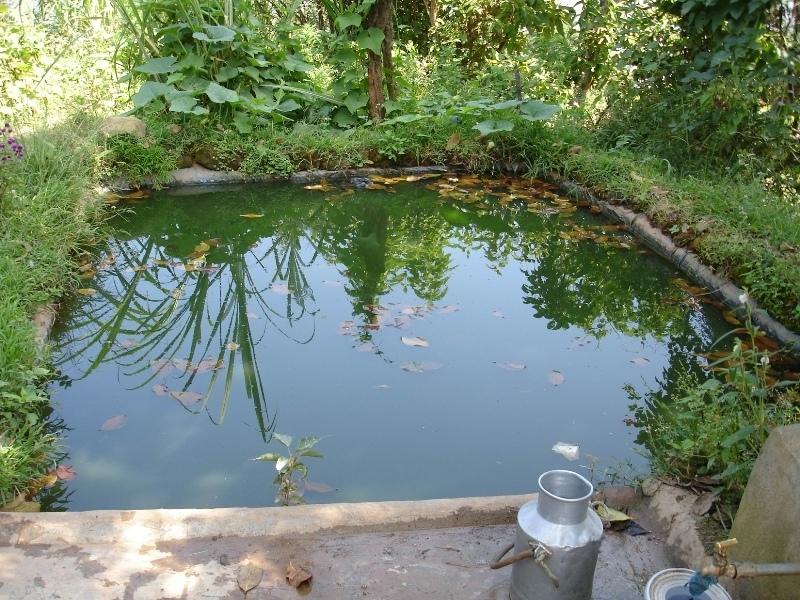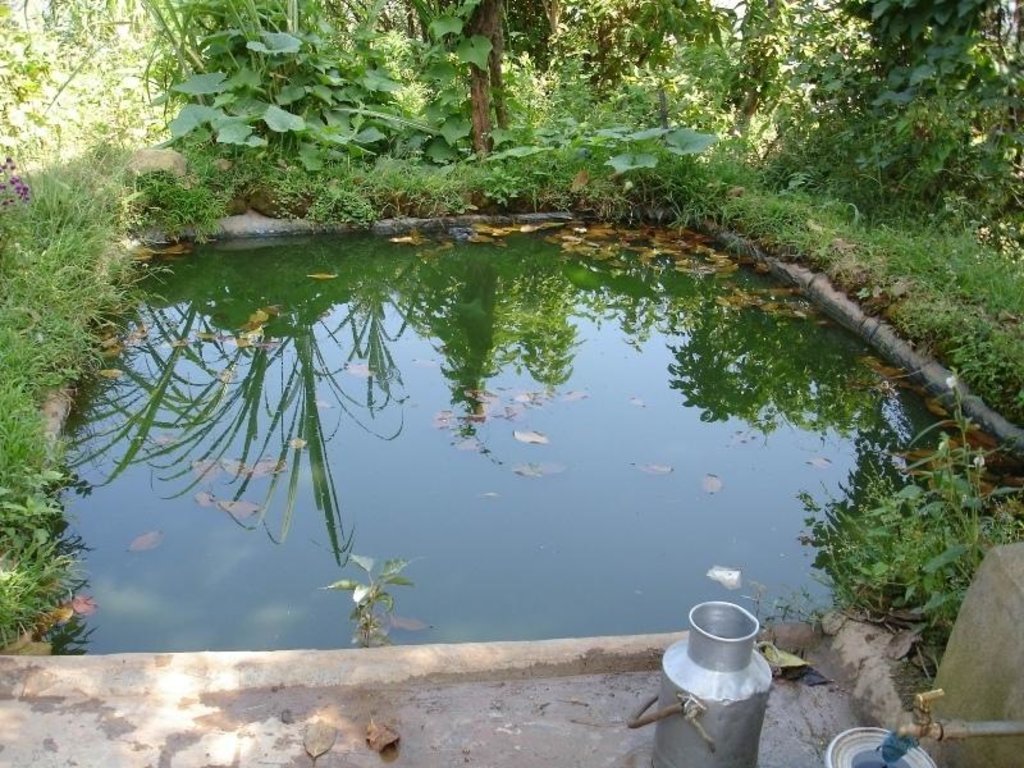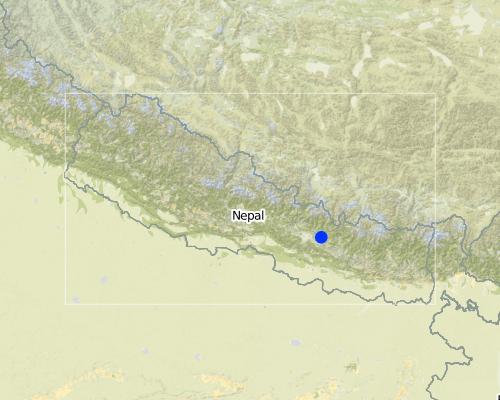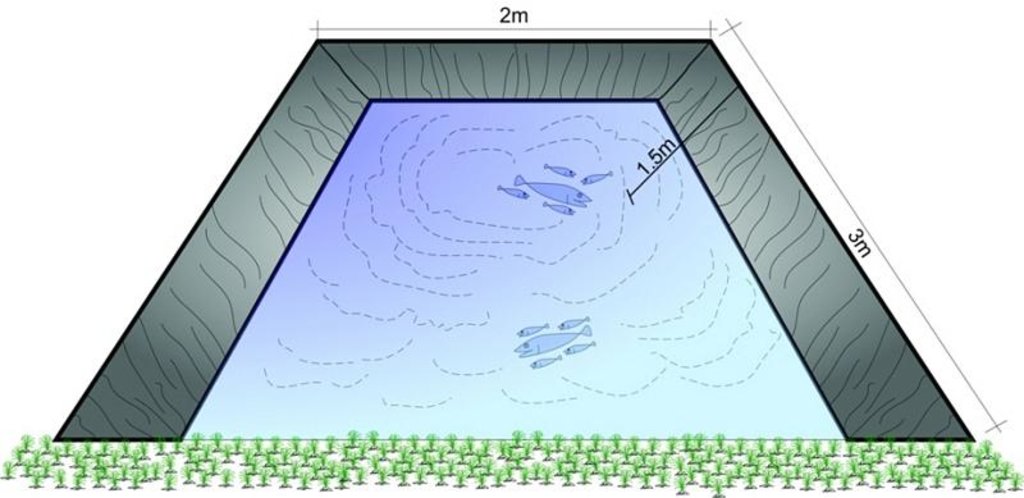Plastic-lined conservation pond to store irrigation water [Nepal]
- Creation:
- Update:
- Compiler: Madhav Dhakal
- Editor: –
- Reviewer: David Streiff
Plastic bichchhayeko Samrakshan pokhari - Nepali
technologies_1462 - Nepal
View sections
Expand all Collapse all1. General information
1.2 Contact details of resource persons and institutions involved in the assessment and documentation of the Technology
SLM specialist:
Name of the institution(s) which facilitated the documentation/ evaluation of the Technology (if relevant)
ICIMOD International Centre for Integrated Mountain Development (ICIMOD) - Nepal1.3 Conditions regarding the use of data documented through WOCAT
When were the data compiled (in the field)?
30/11/2006
The compiler and key resource person(s) accept the conditions regarding the use of data documented through WOCAT:
Yes
2. Description of the SLM Technology
2.1 Short description of the Technology
Definition of the Technology:
A plastic-lined dugout pond to store runoff and household wastewater for irrigation purposes during dry periods
2.2 Detailed description of the Technology
Description:
Water harvesting technology is very useful in areas where there is limited rainfall for long periods of the year. These dry periods severely limit the growing of crops across Nepal’s middle mountains especially on steep slopes where conventional irrigation can be difficult to arrange. Plastic-lined conservation ponds store water for irrigation more efficiently than the traditional earthen ponds which lose much water to seepage.
The ponds are dug out and the earthen walls lined with high density polyethylene (HDPE) sheet or SILPAULIN (multi-layered, cross laminated, UV stabilised) heavy duty plastic sheeting. The size of the pond will vary depending on the area available and the soil characteristics. The PARDYP project tested and demonstrated plastic-lined ponds with a capacity of 8,000-10,000 litres. These ponds were about 3m long, 2m wide and 1.5m deep and were located at shady sites to minimise evaporation losses.
The conservation ponds tested and demonstrated by the PARDYP project were used for irrigating high value off-season horticultural crops (vegetables, fruit, and spices). These crops were irrigated with drip irrigation and micro sprinklers (see sheets QT NEP6 and QT NEP21). The ponds were fed from rainwater, upland springs and taps, and household wastewater.
The ponds were established during the dry season in three days. They were prepared by selecting a suitable site with a sufficient catchment; mapping out the area and depth of the pond; digging out the soil; removing protruding stones and roots; and compacting and smoothing the sides and bottom of the pond. Then the sides and bottom of the pond were lined with sieved soil followed by plastic sheet, which was anchored by stones and soil.
The main maintenance activity is to prevent livestock and people from entering the pond to avoid damaging the sheet. The pond should not be allowed to dry up as this would let rats damage the sheet. The sediment that accumulates in the pond should be removed once a year carefully by hand only as the use of agricultural tools could puncture the sheet.
2.3 Photos of the Technology
2.5 Country/ region/ locations where the Technology has been applied and which are covered by this assessment
Country:
Nepal
Further specification of location:
Kavrepalanchowk district/ Lamdihi, Patalekhet, Chiuribot, villages of Jhikhu Khola watershed
Map
×2.6 Date of implementation
If precise year is not known, indicate approximate date:
- more than 50 years ago (traditional)
2.7 Introduction of the Technology
Specify how the Technology was introduced:
- through projects/ external interventions
Comments (type of project, etc.):
It is an ancient water management technique, later adapted according to the local condition.
3. Classification of the SLM Technology
3.1 Main purpose(s) of the Technology
- Improve water availability
3.2 Current land use type(s) where the Technology is applied

Cropland
- Annual cropping
Main crops (cash and food crops):
major cash crop: Tomato and potato
major food crop: Rice and wheat
other: Mustard and legumes
Comments:
Major land use problems (compiler’s opinion): 1. Small landholdings which are mostly rainfed for cropping.
2. Low soil fertility status and high susceptibility to erosion.
3. Limited supplies of irrigation water and poor irrigation infrastructure.
Major land use problems (land users’ perception): The farmers experience serious constraints in terms of adopting better farming options, e.g., cash crops due to soil fertility and soil moisture problems.
Type of cropping system and major crops comments: Maize- wheat/ vegetables
3.3 Further information about land use
Water supply for the land on which the Technology is applied:
- rainfed
Number of growing seasons per year:
- 3
Specify:
Longest growing period in days: 150; Longest growing period from month to month: Jun - Oct; Second longest growing period in days: 120; Second longest growing period from month to month: Nov - Feb
3.4 SLM group to which the Technology belongs
- water harvesting
3.5 Spread of the Technology
Specify the spread of the Technology:
- applied at specific points/ concentrated on a small area
3.6 SLM measures comprising the Technology

structural measures
- S4: Level ditches, pits
3.7 Main types of land degradation addressed by the Technology

water degradation
- Hs: change in quantity of surface water
3.8 Prevention, reduction, or restoration of land degradation
Specify the goal of the Technology with regard to land degradation:
- reduce land degradation
4. Technical specifications, implementation activities, inputs, and costs
4.1 Technical drawing of the Technology
4.2 Technical specifications/ explanations of technical drawing
Plastic- linined conservation pond
Location: Patalekhet, Lamdihi and Chiurobot.. Kavrepalanchowk
Technical knowledge required for field staff / advisors: moderate
Technical knowledge required for land users: moderate
Main technical functions: water harvesting / increase water supply
Secondary technical functions: control of dispersed runoff: retain / trap
Structural measure: pond
Depth of ditches/pits/dams (m): 1.5
Width of ditches/pits/dams (m): 2
Length of ditches/pits/dams (m): 3
Construction material (earth): It is a earth excavated pit with earthen side walls
Construction material (other): plasitc sheet - Lining of a HDPE sheet or SILPAULIN (Multi-layered, cross laminated, UV stabilized p
4.3 General information regarding the calculation of inputs and costs
Specify how costs and inputs were calculated:
- per Technology unit
Specify unit:
Pond
Specify volume, length, etc. (if relevant):
3m long, 2m wide and 1.5m deep
Specify currency used for cost calculations:
- US Dollars
Indicate average wage cost of hired labour per day:
2.10
4.4 Establishment activities
| Activity | Type of measure | Timing | |
|---|---|---|---|
| 1. | Select a preferably fl at site with a suffi cient catchment area | Structural | dry months |
| 2. | Measure the area to be irrigated and estimate the size of the pond | Structural | dry months |
| 3. | Measure and mark out the pond | Structural | 1st day |
| 4. | Dig out the soil to the pre-determined depth | Structural | 1st day |
| 5. | Remove protruding stones and roots | Structural | 2nd day |
| 6. | Compacting and smooting the sides and bottom of the pond. | Structural | 2nd day |
| 7. | Line the sides and bottom of the pond with sieved soil (preferably a clay | Structural | 2nd day |
| 8. | Lay out the plastic sheets without any folds over the pond with | Structural | 3rd day |
| 9. | Overlay thick fine soil on the plastic sheet | Structural | 3rd day |
| 10. | Anchor the edges of the sheet at the rim of the pond with stones and soil. | Structural | 3rd day |
4.5 Costs and inputs needed for establishment
| Specify input | Unit | Quantity | Costs per Unit | Total costs per input | % of costs borne by land users | |
|---|---|---|---|---|---|---|
| Labour | Dig out pond | persons/unit | 3.0 | 2.1 | 6.3 | 100.0 |
| Equipment | Plastic | unit | 1.0 | 29.2 | 29.2 | |
| Total costs for establishment of the Technology | 35.5 | |||||
Comments:
Duration of establishment phase: 3 month(s)
4.6 Maintenance/ recurrent activities
| Activity | Type of measure | Timing/ frequency | |
|---|---|---|---|
| 1. | Prevent livestock and humans from entering the pond | Structural | daily/regularly |
| 2. | Ensure that the pond is not allowed to dry out completely as this could | Structural | dry months./regularly, |
| 3. | Removing accumulated sediment once a year carefully by hand (using | Structural | dry months./once in a year. |
4.7 Costs and inputs needed for maintenance/ recurrent activities (per year)
| Specify input | Unit | Quantity | Costs per Unit | Total costs per input | % of costs borne by land users | |
|---|---|---|---|---|---|---|
| Labour | Clean and maitaining the pond | persons/unit | 3.0 | 2.1 | 6.3 | 100.0 |
| Total costs for maintenance of the Technology | 6.3 | |||||
Comments:
Machinery/ tools: measuring tape, spade, shovel, knife, hoe, hammer, trowel, and pan
The cost given above is for unit technology having 9000 litre capacity as in 2006.
4.8 Most important factors affecting the costs
Describe the most determinate factors affecting the costs:
Cost of plastic, members of a household contributed as labour in all sites.
5. Natural and human environment
5.1 Climate
Annual rainfall
- < 250 mm
- 251-500 mm
- 501-750 mm
- 751-1,000 mm
- 1,001-1,500 mm
- 1,501-2,000 mm
- 2,001-3,000 mm
- 3,001-4,000 mm
- > 4,000 mm
Specify average annual rainfall (if known), in mm:
1070.00
Agro-climatic zone
- humid
Thermal climate class: subtropics
5.2 Topography
Slopes on average:
- flat (0-2%)
- gentle (3-5%)
- moderate (6-10%)
- rolling (11-15%)
- hilly (16-30%)
- steep (31-60%)
- very steep (>60%)
Landforms:
- plateau/plains
- ridges
- mountain slopes
- hill slopes
- footslopes
- valley floors
Altitudinal zone:
- 0-100 m a.s.l.
- 101-500 m a.s.l.
- 501-1,000 m a.s.l.
- 1,001-1,500 m a.s.l.
- 1,501-2,000 m a.s.l.
- 2,001-2,500 m a.s.l.
- 2,501-3,000 m a.s.l.
- 3,001-4,000 m a.s.l.
- > 4,000 m a.s.l.
5.3 Soils
Soil depth on average:
- very shallow (0-20 cm)
- shallow (21-50 cm)
- moderately deep (51-80 cm)
- deep (81-120 cm)
- very deep (> 120 cm)
Soil texture (topsoil):
- medium (loamy, silty)
- fine/ heavy (clay)
If available, attach full soil description or specify the available information, e.g. soil type, soil PH/ acidity, Cation Exchange Capacity, nitrogen, salinity etc.
Soil fertility is medium
Soil drainage / infiltration is good
Soil water storage capacity is medium
5.4 Water availability and quality
Water quality (untreated):
poor drinking water (treatment required)
Comments and further specifications on water quality and quantity:
Water quality (untreated): Also good. More in rainy season (June- September), less in April/May; source: spring
5.6 Characteristics of land users applying the Technology
Market orientation of production system:
- mixed (subsistence/ commercial
Off-farm income:
- 10-50% of all income
Relative level of wealth:
- poor
- average
Individuals or groups:
- individual/ household
Level of mechanization:
- manual work
- animal traction
Gender:
- women
- men
Indicate other relevant characteristics of the land users:
Land users applying the Technology are mainly common / average land users
Population density: 200-500 persons/km2
Annual population growth: 2% - 3%
80% of the land users are average wealthy and own 90% of the land (ranked by land users).
20% of the land users are poor and own 10% of the land.
Off-farm income specification: In most farm households, off-farm income plays at least a minor and
increasingly a major role. Occasional opportunities for off-farm income present themselves in the form of daily
labour wages. Some households’ members receive regular salaries, whilst an increasing number of Nepalis are
working in India, the Middle East, Malaysia, and elsewhere and sending remittance incomes home.
Market orientation of production system: Vegetables- commercial
Level of mechanization: Manual labour consists of planting, irrigation , harvesting, while field field preparation is carried out by animals, also machines but just in valley bottom.
5.7 Average area of land owned or leased by land users applying the Technology
- < 0.5 ha
- 0.5-1 ha
- 1-2 ha
- 2-5 ha
- 5-15 ha
- 15-50 ha
- 50-100 ha
- 100-500 ha
- 500-1,000 ha
- 1,000-10,000 ha
- > 10,000 ha
Is this considered small-, medium- or large-scale (referring to local context)?
- medium-scale
5.8 Land ownership, land use rights, and water use rights
Land ownership:
- individual, titled
Land use rights:
- individual
Water use rights:
- open access (unorganized)
- communal (organized)
6. Impacts and concluding statements
6.1 On-site impacts the Technology has shown
Socio-economic impacts
Production
production area
land management
Income and costs
farm income
Comments/ specify:
due to availability of more water for irrigation
Socio-cultural impacts
community institutions
Comments/ specify:
due to informal network of farmers with ponds
SLM/ land degradation knowledge
Comments/ specify:
farmers discuss and share experiences
livelihood and human well-being
Comments/ specify:
increased vegetable production, more income from vegetables.
Ecological impacts
Soil
soil moisture
soil cover
Comments/ specify:
fallow land is turned into cropped land
6.2 Off-site impacts the Technology has shown
downstream flooding
Comments/ specify:
due to trapped runoff
6.3 Exposure and sensitivity of the Technology to gradual climate change and climate-related extremes/ disasters (as perceived by land users)
Gradual climate change
Gradual climate change
| Season | Type of climatic change/ extreme | How does the Technology cope with it? | |
|---|---|---|---|
| annual temperature | increase | not known |
Climate-related extremes (disasters)
Meteorological disasters
| How does the Technology cope with it? | |
|---|---|
| local rainstorm | well |
| local windstorm | well |
Climatological disasters
| How does the Technology cope with it? | |
|---|---|
| drought | not well |
Hydrological disasters
| How does the Technology cope with it? | |
|---|---|
| general (river) flood | not well |
Other climate-related consequences
Other climate-related consequences
| How does the Technology cope with it? | |
|---|---|
| reduced growing period | well |
6.4 Cost-benefit analysis
How do the benefits compare with the establishment costs (from land users’ perspective)?
Short-term returns:
positive
Long-term returns:
very positive
How do the benefits compare with the maintenance/ recurrent costs (from land users' perspective)?
Short-term returns:
very positive
Long-term returns:
very positive
Comments:
Perception of land users who accepted the technology by getting
incentives from the PARDYP project. If incentives are not available the short-term costs and benefits would be equal.
6.5 Adoption of the Technology
- more than 50%
If available, quantify (no. of households and/ or area covered):
5 households in an area of 10 ha
Of all those who have adopted the Technology, how many have did so spontaneously, i.e. without receiving any material incentives/ payments?
- 0-10%
Comments:
100% of land user families have adopted the Technology with external material support
5 land user families have adopted the Technology with external material support
Comments on acceptance with external material support: survey results
Comments on spontaneous adoption: survey results
There is no trend towards spontaneous adoption of the Technology
Comments on adoption trend: because of the expense of the plastic sheet and it not being locally available
6.7 Strengths/ advantages/ opportunities of the Technology
| Strengths/ advantages/ opportunities in the land user’s view |
|---|
|
Water is sufficient to irrigate 2-3 ropani( 1 ropani = 508 sq.m.)land in one season. How can they be sustained / enhanced? Advantages of the technology should be shared with large number of people. |
| Plastic pond lasted more than 5 years and it is leak proof. |
| Strengths/ advantages/ opportunities in the compiler’s or other key resource person’s view |
|---|
|
Good income from sales of vegetables in the dry season can be achieved even from a small piece of land How can they be sustained / enhanced? Advantages of the technology should be more widely shared |
|
The source of water for these ponds was not only rainwater but also other sources like springs and taps, These ponds are fed with rainwater and household wastewater and from springs and taps. The ponded water was mainly used for micro irrigation including drip irrigation and micro-sprinklers How can they be sustained / enhanced? Promote the use of other water conserving techniques like mulching when using the harvested water |
|
Reduced the dependence on large scale water supply schemes How can they be sustained / enhanced? Harvest all possible sources of water |
|
No seepage loss observed fi ve years after building the ponds meaning that the plastic lasts at least five years How can they be sustained / enhanced? Continue trials |
6.8 Weaknesses/ disadvantages/ risks of the Technology and ways of overcoming them
| Weaknesses/ disadvantages/ risks in the land user’s view | How can they be overcome? |
|---|---|
| Plastic pond is expensive for poor farmers. | subsidised cost for poors |
| unsafe for small childrens | Protection structures should be constructed. |
| Weaknesses/ disadvantages/ risks in the compiler’s or other key resource person’s view | How can they be overcome? |
|---|---|
| SILPAULIN (multi-layered, cross laminated, UV stabilized) heavy duty plastic is not available in local markets and is expensive for poor farmers | Make it available in the local market at a subsidised cost for poor farmers. |
| The ponds attract insects, mainly mosquitoes, that cause disease; and the ponds are unsafe for small children | Regularly clean the pond and fence them in |
7. References and links
7.2 References to available publications
Title, author, year, ISBN:
ICIMOD (2007) Good Practices in Watershed Management, Lessons Learned in the Mid Hills of Nepal. Kathmandu: ICIMOD
Available from where? Costs?
ICIMOD
Title, author, year, ISBN:
SCWMC (2004) Soil Conservation and Watershed Management Measures and Low Cost Techniques. Kathmandu: Government of Nepal, Soil Conservation and Watershed Management Component - Department of Soil Conservation and Watershed Management
Available from where? Costs?
DSCWM, Kathmandu
Title, author, year, ISBN:
Shafi q, M.; Ikram, M.Z.; Nasir, A. (1995) Water Harvesting Techniques for Sustainable Agriculture in Dry and Cold Mountain Areas. Paperpresented at the Workshop on Sustainable Agriculture in Dry and Cold Mountain Areas, Pakistan Agricultural Research Council, 25-27 September1995, Queta, Pakistan
Available from where? Costs?
ICIMOD
Links and modules
Expand all Collapse allLinks
No links
Modules
No modules





